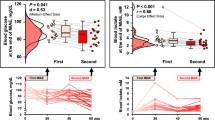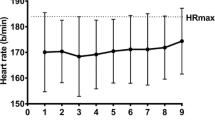Summary
Thirty-three college women (mean age=21.8 years) participated in a 5 d·wk−1, 12 week training program. Subjects were randomly assigned to 3 groups, above lactate threshold (> LT) (N=11; trained at 69 watts above the workload associated with LT), =LT (N=12; trained at the work load associated with LT) and control (C) (N=10). Subjects were assessed for \(\dot V_{O_{2\max } } \), \(\dot V_{O_2 } \)LT, \(\dot V_{O_2 } \)LT/\(\dot V_{O_{2\max } } \), before and after training, using a discontinuous 3 min incremental (starting at 0 watts increasing 34 watts each work load) protocol on a cycle ergometer (Monark). Respiratory gas exchange measures were determined using standard open circuit spirometry while LT was determined from blood samples taken immediately following each work load from an indwelling venous catheter located in the back of a heated hand. Body composition parameters were determined before and after training via hydrostatic weighing. Training work loads were equated so that each subject expended approximately 1465 kJ per training session (Monark cycle ergometer) regardless of training intensity. Pretraining, no significant differences existed between groups for any variable. Post training the > LT group had significantly higher \(\dot V_{O_{2\max } } \) (13%), \(\dot V_{O_2 } \) (47%) and \(\dot V_{O_2 } \)LT/\(\dot V_{O_{2\max } } \) (33%) values as compared to C (p<.05). Within group comparisons revealed that none of the groups significantly changed \(\dot V_{O_{2\max } } \) as a result of training, only the > LT group showed a significant increase in \(\dot V_{O_2 } \) (48%) (p<.05), while both the = LT and > LT group showed significant increases in \(\dot V_{O_2 } \)LT/\(\dot V_{O_{2\max } } \) (= LT 16%, > LT 42% (p<.05)). No differences were found between or within groups post training for body composition parameters. It was concluded that training above the LT results in an improvement in \(\dot V_{O_2 } \)LT and that large improvements in \(\dot V_{O_{2\max } } \) may not be required for large improvements in \(\dot V_{O_2 } \).
Similar content being viewed by others
References
American College of Sports Medicine (1978) Position statement on the recommended quantity and quality of exercise for developing and maintaining fitness in healthy adults. Med Sci Sports 10
Brozek J, Grande F, Anderson JT, Keyes A (1963) Densiometric analysis of body compositon: Revision of some quantitative assumptions. Ann NY, Acad Sci 110:113–140
Costill DL, Gollnick PD, Jansson ED, Saltin B, Stein EM (1973a) Glycogen depletion pattern in human muscle fibers during distance running. Acta Physiol Scand 89:374–383
Costill DL, Thomason H, Roberts E (1973b) Fractional utilization of the aerobic capacity during distance running. Med Sci Sports 5:248–252
Davis JA, Frank MH, Whipp BJ, Wasserman K (1979) Anaerobic threshold alterations cuased by endurance training in middle-aged men. J Appl Physiol: Respirat Environ Exercise Physiol 46:1039–1046
Davis JA, Vodak P, Wilmore JH, Vodak J, Kurtz P (1976) Anaerobic threshold and maximal aerobic power for three modes of exercise. J Appl Physiol 41:544–550
Denis C, Fouquet R, Poty P, Geyssant A, Lacour JR (1982) Effect of 40 weeks of endurance training on the anaerobic threshold. Int J Sports Med 3:208–214
Dwyer J, Bybee R (1983) Heart rate indices of the anaerobic threshold. Med Sci Sports Exerc 15:72–76
Farrell PA, Wilmore JH, Coyle EF, Billing JE, Costill DL (1979) Plasma lactate accumulation and distance running performance. Med Sci Sports Exercise 11:338–344
Flint MM, Drinkwater BL, Horvath SM (1974) Effects of training on women's response to submaximal exercise. Med Sci Sports 6:89–94
Forster HV, Dempsey JA, Thomason J, Vidruk E, DoPico GA (1972) Estimation of arterial PO2, PCO2, pH, and lactate from arterialized venous blood. J Appl Physiol 32:134–137
Green HJ, Hughson RL, Orr GW, Ranney DA (1983) Anaerobic threshold, blood lactate, and muscle metabolites in progressive exercise. J Appl Physiol: Respirat Environ Exercise Physiol 54:1032–1038
Gutman I, Wahlefeld AW (1974) L-(+) Lactate. Determination with lactate dehydrogenase and NAD. Second English Edition. Academic Press Inc, New York, pp 1464–1468
Issekutz, Jr, B, Shaw WAS, Issekutz TB (1975) Effect of lactate on FFA and glycerol turnover in resting and exercising dogs. J Appl Physiol 39:349–353
Ivy JL, Costill DL, Van Handel PJ, Essig DA, Lower RW (1981) Alteration in the lactate threshold with changes in substrate availability. Int J Sports Med 2:139–142
Ivy JL, Withers RT, Van Handel PJ, Elger DH, Costill DL (1980) Muscle respiratory capacity and fiber type as determinants of the lactate threshold. J Appl Physiol: Respirat Environ Exerc Physiol 48:523–527
Karlsson J, Jacobs I (1982) Onset of blood lactate accumulation during muscular exercise as a threshold concept. I. Theoretical considerations. Int J Sports Med 3:190–201
Katch FI, Michael ED, Horvath SM (1967) Estimation of body volume by underwater weighing: Description of a simple method. J Appl Physiol 28:811–813
Katch V, Weltman A, Sady S, Freedson P (1978) Validity of the relative percent concept for equating training intensity. Eur J Appl Physiol 39:219–227
Kilbom A Physical training in women. (1971) Scand Clin Lab Invest 28:[Supl] 119 1–34
Kinderman W, Simon G, Keul J (1979) The significance of the aerobic-anaerobic transition for determination of work load intensities during endurance training. Eur J Appl Physiol 42:25–34
LaFontaine TP, Londeree BR, Spath WK (1981) The maximal steady state versus selected running events. Med Sci Sports Exerc 13:190–192
Niemelia K, Palatsi I, Linnaluoto M, Takkunen J (1980) Criteria for maximum oxygen uptake in progressive bicycletests. Eur J Appl Physiol 44:51–59
Rusko H, Rahkila P, Karvinen E (1980) Anaerobic threshold, skeletal muscle enzymes and fiber composition in young female cross-country skiers. Acta Physiol Scand 108:263–269
Sady S, Katch V, Freedson P, Weltman A (1980) Changes in metabolic acidosis: evidence for an intensity threshold. J Sports Med 20:41–46
Shire TL, Avallone Jr, JP, Boileau RA, Lohman TG, Wirth JC (1977) Effect of high resistance and low resistance bicycle ergometer training in college women on cardiorespiratory function and body composition. Res Quart 48:391–400
Sjodin B, Jacobs I, Svendenhag J (1982) Changes in the onset of blood lactate accumulation (OBLA) and muscle enzymes after training at OBLA. Eur J Appl Physiol 49:45–47
Tanaka K, Mausuura Y, Kumagai S, Matsuzaka A, Hirakoba K, Asano K (1983) Relationships of anaerobic threshold and onset of blood lactate accumulation with endurance performance. Eur J Appl Physiol 52:51–56
Tesch PA, Sharp DS, Daniels WL (1981) Influence of fiber type composition and capillary density on onset of blood lactate accumulation. Int J Sports Med 2:252–255
Wasserman K, Whipp BJ, Koyal SN, Beaver WL (1973) Anaerobic threshold and respiratory gas exhange during exercise. J Appl Physiol 32:236–243
Weltman A, Katch V, Sady S, Freedson P (1978) Onset of metabolic acidosis (anaerobic threshold) as a criterion measure of submaximum fitness. Res Quart 49:218–227
Weltman A, Katch VL (1979) Relationship between the onset of metabolic acidosis and maximal oxygen uptake. J Sports Med 19:133–142
Wilmore JH (1969) Simplified method for determination of residual lung volume. J Appl Physiol 27:96–100
Yoshida T, Suda Y, Takeuchi N (1982) Endurance training regimen based upon arterial blood lactate: effects on anaerobic threshold. Eur J Appl Physiol 49:223–230
Author information
Authors and Affiliations
Additional information
Data were collected at the Human Performance Laboratory, University of Colorado
Rights and permissions
About this article
Cite this article
Henritze, J., Weltman, A., Schurrer, R.L. et al. Effects of training at and above the lactate threshold on the lactate threshold and maximal oxygen uptake. Europ. J. Appl. Physiol. 54, 84–88 (1985). https://doi.org/10.1007/BF00426304
Accepted:
Issue Date:
DOI: https://doi.org/10.1007/BF00426304




